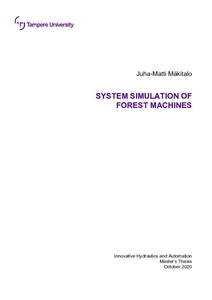System simulation of forest machines
Mäkitalo, Juha-Matti (2020)
Mäkitalo, Juha-Matti
2020
Automaatiotekniikan DI-ohjelma - Master's Programme in Automation Engineering
Tekniikan ja luonnontieteiden tiedekunta - Faculty of Engineering and Natural Sciences
This publication is copyrighted. You may download, display and print it for Your own personal use. Commercial use is prohibited.
Hyväksymispäivämäärä
2020-10-27
Julkaisun pysyvä osoite on
https://urn.fi/URN:NBN:fi:tuni-202010197394
https://urn.fi/URN:NBN:fi:tuni-202010197394
Tiivistelmä
This master’s thesis has been done in cooperation with Ponsse Plc. The aim of this thesis is to create a basis for Ponsse’s system simulation by mapping the simulation software that meet Ponsse’s requirements as well as possible and to test the combination of the selected software by simulating a K121 loader. In system simulation, the aim is to simulate different areas in the same simulation model, which are mechanics (multibody dynamics), hydraulics and control system in this thesis. In addition, forest machine’s power train, electrics or environment, for example, could be simulated.
Different software options for system simulation were mapped out through visits and meetings with other companies and software suppliers. Also, Mevea simulation software was introduced in the form of a training course.
The selected simulation software are Mevea (mechanics), Amesim (hydraulics) and Simulink (control system). Simulink was the only simulation software that had been chosen before the beginning of this thesis. The combination of the simulation software mentioned above was able to simulate the K121 loader in real-time with a time step of 1 ms. Mevea is a master software, while Amesim and Simulink are slave software. An FMU principle and shared memory area were applied to the interfaces between the different simulation software, and the simulation principle was co-simulation.
Different software options for system simulation were mapped out through visits and meetings with other companies and software suppliers. Also, Mevea simulation software was introduced in the form of a training course.
The selected simulation software are Mevea (mechanics), Amesim (hydraulics) and Simulink (control system). Simulink was the only simulation software that had been chosen before the beginning of this thesis. The combination of the simulation software mentioned above was able to simulate the K121 loader in real-time with a time step of 1 ms. Mevea is a master software, while Amesim and Simulink are slave software. An FMU principle and shared memory area were applied to the interfaces between the different simulation software, and the simulation principle was co-simulation.
